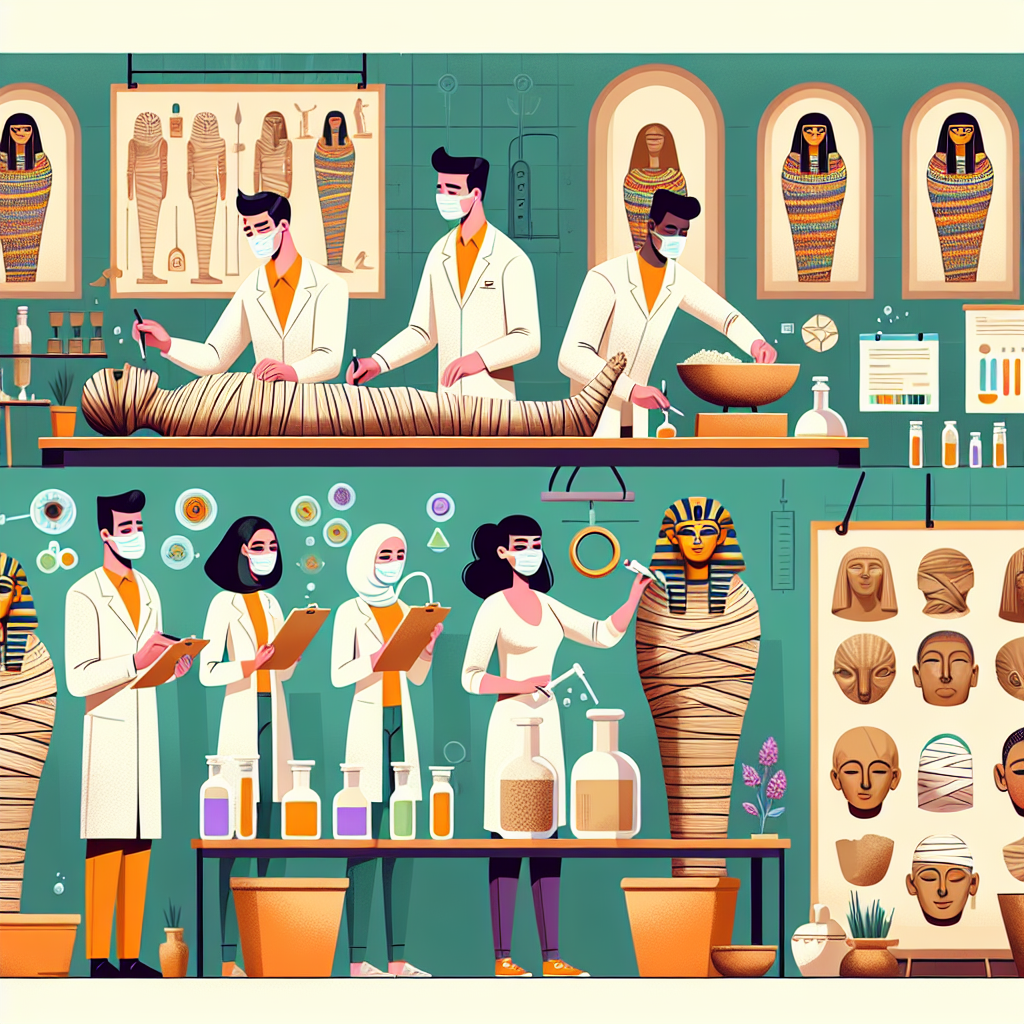Researchers have recently done an interesting study on the smells coming from nine mummified bodies. They found that ancient Egyptian mummies give off scents that are described as “woody,” “spicy,” and “sweet.” To carry out this study, they used both “trained human sniffers” and special equipment that works like an electronic nose. This research shows that smell played an important role in the mummification process. The ancient Egyptians likely used different resins and oils, like pine, cedar, and juniper, to create nice smells that have lasted for over 5,000 years.
The results of this study were published in the Journal of the American Chemical Society. The researchers believe that analyzing scents can be a non-invasive way to study preserved bodies. They hope to recreate these ancient smells in museums, which would make visits more enjoyable and help people understand mummified artifacts better. This new method not only gives us insights into how ancient Egyptians mummified their dead but also highlights how important smells are in understanding cultural history.
This study involved teams from University College London (UCL) and the University of Ljubljana in Slovenia, along with experts from the Egyptian Museum in Cairo. The lead author, Professor Matija Strlic, mentioned that the idea of smelling mummified bodies has always intrigued both scientists and the public. However, this research is the first detailed study of its kind, providing important information about how mummies are preserved and what materials were used in ancient embalming.
Co-author Professor Ali Abdelhalim, who is also the director of the Egyptian Museum in Cairo, stressed how important mummification was in ancient Egyptian culture. He explained that this careful process aimed to keep both the body and soul safe for the afterlife by using various oils, waxes, and balms. By figuring out the different methods and materials used in mummification, researchers can learn more about the history, location, and social status of the people who were mummified. The team used various scientific methods to analyze the chemicals from the mummies, and they plan to create “smellscapes” in museums to help visitors experience this important part of ancient Egyptian culture.
Original news source: Ancient Egyptian mummies smell ‘sweet’ and ‘spicy’, researchers say (Sky News)
🎧 Listen:
Slow
Normal
Fast
📖 Vocabulary:
| 1 | mummified | Bodies that have been preserved, often by wrapping in cloth |
| 2 | scents | Smells or odors |
| 3 | resins | Sticky substances from trees used in making perfumes or varnishes |
| 4 | non-invasive | Not involving cutting into the body or causing harm |
| 5 | artifacts | Objects made by humans, typically of historical interest |
| 6 | embalming | The process of preserving a body after death |
| 7 | intrigued | Very interested or curious |
| 8 | balms | Creamy substances used to heal or protect the skin |
| 9 | insights | Understanding or knowledge gained about something |
| 10 | preserved | Kept in good condition over time |
| 11 | cultural | Related to the ideas, customs, and social behavior of a society |
| 12 | embalming | The process of preserving a body after death |
| 13 | analyze | To examine something in detail to understand it better |
| 14 | chemicals | Substances used in or produced by a chemical process |
| 15 | smellscapes | Areas designed to recreate or represent smells, often in a museum setting |
Group or Classroom Activities
Warm-up Activities:
– CHARADES
Instructions: Divide the class into small groups. Each group will take turns acting out words or phrases related to the article, such as “mummification,” “ancient Egypt,” or “scents.” The other groups will guess the word or phrase being acted out. This activity will help students engage with vocabulary in a fun way.
– HEADLINE CREATION
Instructions: Have students read a brief summary of the article. Then, ask them to create a catchy headline that captures the essence of the study on mummified bodies and their scents. After they come up with their headlines, students can share them with the class for discussion.
– OPINION POLL
Instructions: Pose a question related to the article, such as, “Do you think that smells can affect our understanding of history?” Have students form small groups to discuss their opinions and then conduct a poll in the class to see how many agree or disagree. This activity encourages critical thinking and speaking skills.
– WORD ASSOCIATION
Instructions: Write the word “mummy” on the board. Students will take turns saying a word that is related to “mummy” or the content of the article (e.g., “Egypt,” “preservation,” “scents”). This continues until students run out of ideas. This activity helps reinforce vocabulary and associations.
– MIND MAP
Instructions: On a large piece of paper or a whiteboard, have students create a mind map based on the article. They should start with the central idea of “ancient Egyptian mummies” and branch out with related concepts such as “scents,” “mummification,” “cultural history,” and names of the researchers. This visual representation aids in comprehension and retention of information.
🤔 Comprehension Questions:
1. What scents were identified by researchers coming from the ancient Egyptian mummies?
2. How did the researchers conduct their study on the smells of the mummified bodies?
3. Why do the researchers think that analyzing scents can be a useful method for studying preserved bodies?
4. What materials did the ancient Egyptians likely use to create the pleasant smells associated with mummies?
5. What is the significance of the study being published in the Journal of the American Chemical Society?
6. Who were the main contributors to this research study, and what roles did they play?
7. How does the mummification process reflect the beliefs of ancient Egyptians regarding the afterlife?
8. What future plans do the researchers have for using the findings of their study in museums?
Go to answers ⇩
🎧✍️ Listen and Fill in the Gaps:
Researchers have recently done an interesting study on the smells (1)______ from nine mummified bodies. They found that ancient Egyptian mummies give off (2)______ that are described as “woody,” “spicy,” and “sweet.” To carry out this study, they used both “trained human sniffers” and special equipment that works like an electronic nose. This research (3)______ that smell played an important role in the mummification (4)______. The ancient Egyptians likely used different resins and oils, like pine, cedar, and juniper, to create nice smells that have lasted for over 5,000 years.
The results of this study were published in the Journal of the American Chemical Society. The researchers believe that analyzing scents can be a non-invasive way to study preserved bodies. They hope to recreate these ancient (5)______ in (6)______, which would make visits more enjoyable and help (7)______ understand mummified artifacts better. This new method not only gives us insights into how ancient Egyptians mummified their dead but also highlights how important smells are in understanding (8)______ history.
This study involved teams from University College London (UCL) and the University of Ljubljana in Slovenia, along with experts from the Egyptian Museum in Cairo. The lead author, (9)______ Matija Strlic, mentioned that the idea of smelling mummified bodies has always intrigued both scientists and the (10)______. However, this research is the first detailed study of its kind, providing important information about how mummies are preserved and what materials were used in ancient (11)______.
Co-author Professor Ali Abdelhalim, who is also the (12)______ of the Egyptian Museum in Cairo, stressed how important mummification was in ancient Egyptian culture. He explained that this careful process aimed to keep both the body and soul safe for the afterlife by using various oils, (13)______, and balms. By (14)______ out the different methods and materials used in mummification, researchers can learn more about the history, location, and social status of the people who were mummified. The team used various scientific methods to (15)______ the chemicals from the mummies, and they plan to create “smellscapes” in museums to help visitors (16)______ this important part of ancient Egyptian culture.
Go to answers ⇩
💬 Discussion Questions:
Students can ask a partner these questions, or discuss them as a group.
1. What is your favorite smell and why do you like it?
2. How would you feel if you could smell something from thousands of years ago?
3. Do you think smells can bring back memories? Why or why not?
4. What is a scent that reminds you of a special moment in your life?
5. How do you think ancient Egyptians felt about the smells used in mummification?
6. Do you think museums should create “smellscapes”? Why or why not?
7. What is a cultural practice from your country that involves scents or smells?
8. How would you feel if you visited a museum and could smell ancient artifacts?
9. Do you think understanding smells can help us learn more about history? Why?
10. What is a smell that you dislike, and why do you feel that way about it?
11. How would you react if you discovered a new smell that no one had ever experienced before?
12. Do you think scientists should study smells more often? Why or why not?
13. What is a smell that you think is unique to your culture?
14. How do you think the use of scents in ancient times compares to today?
15. Do you like the idea of using scents to enhance storytelling or experiences? Why?
Individual Activities
📖💭 Vocabulary Meanings:
Match each word to its meaning.
Words:
1. mummified
2. scents
3. resins
4. non-invasive
5. artifacts
6. embalming
7. intrigued
8. balms
9. insights
10. preserved
11. cultural
12. embalming
13. analyze
14. chemicals
15. “smellscapes”
Meanings:
(A) Substances used in or produced by a chemical process
(B) Not involving cutting into the body or causing harm
(C) Sticky substances from trees used in making perfumes or varnishes
(D) Areas designed to recreate or represent smells, often in a museum setting
(E) Bodies that have been preserved, often by wrapping in cloth
(F) Objects made by humans, typically of historical interest
(G) The process of preserving a body after death
(H) The process of preserving a body after death
(I) Related to the ideas, customs, and social behavior of a society
(J) Smells or odors
(K) Creamy substances used to heal or protect the skin
(L) Understanding or knowledge gained about something
(M) Very interested or curious
(N) To examine something in detail to understand it better
(O) Kept in good condition over time
Go to answers ⇩
🔡 Multiple Choice Questions:
1. What scents were described in the study of ancient Egyptian mummies?
(a) Woody, spicy, and sweet
(b) Floral, citrus, and minty
(c) Earthy, sour, and pungent
(d) Fresh, salty, and bitter
2. What tools did researchers use to analyze the smells from the mummies?
(a) Chemical test kits and scent bottles
(b) Trained human sniffers and electronic noses
(c) Standard laboratory equipment and gas masks
(d) Air quality monitors and scent diffusers
3. What is one goal of recreating ancient smells in museums?
(a) To sell more tickets to the museum
(b) To compete with other museums
(c) To enhance visitor experience and understanding
(d) To attract more scientists for research
4. Which universities were involved in the study of mummified bodies?
(a) Harvard University and Stanford University
(b) University College London and University of Ljubljana
(c) Oxford University and Cambridge University
(d) Yale University and Princeton University
5. Who is the lead author of the study mentioned in the article?
(a) Professor Ali Abdelhalim
(b) Dr. Sarah Johnson
(c) Professor Matija Strlic
(d) Dr. Michael Thompson
6. What did Professor Ali Abdelhalim emphasize about mummification?
(a) It was a simple process that anyone could do
(b) It was mainly for decorative purposes
(c) It was only practiced by the wealthy
(d) It was crucial for the afterlife in ancient Egyptian culture
7. What did the researchers analyze to learn about mummification?
(a) Chemicals from the mummies
(b) Historical texts and documents
(c) Artifacts from tombs
(d) Ancient Egyptian art styles
8. What is the significance of the study according to the researchers?
(a) It proves that ancient Egyptians were skilled artists
(b) It shows that mummies can be preserved without any materials
(c) It indicates that smells do not matter in archaeology
(d) It provides insights into cultural history and mummification methods
Go to answers ⇩
🕵️ True or False Questions:
1. The study used both trained human tasters and special equipment that functions like an electronic mouth.
2. Ancient Egyptians used resins and oils, such as pine, cedar, and oak, during the mummification process.
3. Mummification was an important cultural practice in ancient Egypt, aimed at preserving the body and soul for the afterlife.
4. The scents from the mummies were described as “woody,” “spicy,” and “sweet.”
5. The researchers aim to recreate modern scents in museums to enhance visitor experiences.
6. The findings were published in the Journal of the European Chemical Society.
7. Researchers studied the smells from nine mummified bodies in ancient Egypt.
8. The study involved teams from University College London and the University of Ljubljana, along with experts from the Egyptian Museum in Cairo.
Go to answers ⇩
📝 Write a Summary:
Write a summary of this news article in two sentences.
Check your writing now with the best free AI for English writing!
Writing Questions:
Answer the following questions. Write as much as you can for each answer.
Check your answers with our free English writing assistant!
1. What interesting scents were found coming from the ancient Egyptian mummies?
2. How did researchers study the smells of the mummified bodies?
3. Why do the researchers want to recreate ancient smells in museums?
4. What did Professor Ali Abdelhalim say about the importance of mummification in ancient Egyptian culture?
5. How can understanding the smells from mummies help researchers learn more about ancient Egyptian history?
✅ Answers
🤔✅ Comprehension Question Answers:
1. What scents were identified by researchers coming from the ancient Egyptian mummies?
Researchers identified scents described as “woody,” “spicy,” and “sweet” coming from the ancient Egyptian mummies.
2. How did the researchers conduct their study on the smells of the mummified bodies?
The researchers used both “trained human sniffers” and special equipment that works like an electronic nose to analyze the smells of the mummified bodies.
3. Why do the researchers think that analyzing scents can be a useful method for studying preserved bodies?
The researchers believe that analyzing scents can be a non-invasive way to study preserved bodies, providing insights into the mummification process and the materials used.
4. What materials did the ancient Egyptians likely use to create the pleasant smells associated with mummies?
The ancient Egyptians likely used different resins and oils, such as pine, cedar, and juniper, to create the pleasant smells associated with mummies.
5. What is the significance of the study being published in the Journal of the American Chemical Society?
The publication in the Journal of the American Chemical Society signifies that the study is recognized within the scientific community and contributes important findings to the field of chemistry and archaeology.
6. Who were the main contributors to this research study, and what roles did they play?
The main contributors were teams from University College London (UCL) and the University of Ljubljana in Slovenia, along with experts from the Egyptian Museum in Cairo. Professor Matija Strlic was the lead author, while Professor Ali Abdelhalim was a co-author and the director of the Egyptian Museum.
7. How does the mummification process reflect the beliefs of ancient Egyptians regarding the afterlife?
The mummification process reflects the ancient Egyptians’ belief that it was important to keep both the body and soul safe for the afterlife, using various oils, waxes, and balms to preserve the deceased.
8. What future plans do the researchers have for using the findings of their study in museums?
The researchers plan to create “smellscapes” in museums to help visitors experience the ancient smells associated with mummies, making visits more enjoyable and informative.
Go back to questions ⇧
🎧✍️✅ Listen and Fill in the Gaps Answers:
(1) coming
(2) scents
(3) shows
(4) process
(5) smells
(6) museums
(7) people
(8) cultural
(9) Professor
(10) public
(11) embalming
(12) director
(13) waxes
(14) figuring
(15) analyze
(16) experience
Go back to questions ⇧
📖💭✅ Vocabulary Meanings Answers:
1. mummified
Answer: (E) Bodies that have been preserved, often by wrapping in cloth
2. scents
Answer: (J) Smells or odors
3. resins
Answer: (C) Sticky substances from trees used in making perfumes or varnishes
4. non-invasive
Answer: (B) Not involving cutting into the body or causing harm
5. artifacts
Answer: (F) Objects made by humans, typically of historical interest
6. embalming
Answer: (G) The process of preserving a body after death
7. intrigued
Answer: (M) Very interested or curious
8. balms
Answer: (K) Creamy substances used to heal or protect the skin
9. insights
Answer: (L) Understanding or knowledge gained about something
10. preserved
Answer: (O) Kept in good condition over time
11. cultural
Answer: (I) Related to the ideas, customs, and social behavior of a society
12. embalming
Answer: (G) The process of preserving a body after death
13. analyze
Answer: (N) To examine something in detail to understand it better
14. chemicals
Answer: (A) Substances used in or produced by a chemical process
15. “smellscapes”
Answer: (D) Areas designed to recreate or represent smells, often in a museum setting
Go back to questions ⇧
🔡✅ Multiple Choice Answers:
1. What scents were described in the study of ancient Egyptian mummies?
Answer: (a) Woody, spicy, and sweet
2. What tools did researchers use to analyze the smells from the mummies?
Answer: (b) Trained human sniffers and electronic noses
3. What is one goal of recreating ancient smells in museums?
Answer: (c) To enhance visitor experience and understanding
4. Which universities were involved in the study of mummified bodies?
Answer: (b) University College London and University of Ljubljana
5. Who is the lead author of the study mentioned in the article?
Answer: (c) Professor Matija Strlic
6. What did Professor Ali Abdelhalim emphasize about mummification?
Answer: (d) It was crucial for the afterlife in ancient Egyptian culture
7. What did the researchers analyze to learn about mummification?
Answer: (a) Chemicals from the mummies
8. What is the significance of the study according to the researchers?
Answer: (d) It provides insights into cultural history and mummification methods
Go back to questions ⇧
🕵️✅ True or False Answers:
1. The study used both trained human tasters and special equipment that functions like an electronic mouth. (Answer: False)
2. Ancient Egyptians used resins and oils, such as pine, cedar, and oak, during the mummification process. (Answer: False)
3. Mummification was an important cultural practice in ancient Egypt, aimed at preserving the body and soul for the afterlife. (Answer: True)
4. The scents from the mummies were described as “woody,” “spicy,” and “sweet.” (Answer: True)
5. The researchers aim to recreate modern scents in museums to enhance visitor experiences. (Answer: False)
6. The findings were published in the Journal of the European Chemical Society. (Answer: False)
7. Researchers studied the smells from nine mummified bodies in ancient Egypt. (Answer: True)
8. The study involved teams from University College London and the University of Ljubljana, along with experts from the Egyptian Museum in Cairo. (Answer: True)
Go back to questions ⇧













